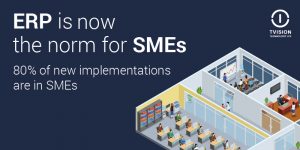In the past, I’ve had to respond to many questions from project stakeholders about implementing ERP software. Some of the most frustrating objections, although often well intentioned, are those based on an outdated or misinformed view of a solution and its capabilities. When implementing an ERP solution, it is important to realise that it is a piece of software that touches almost every part of a business and can have many diverse project stakeholders that need to buy-in to the new business road map. In a space that evolves as rapidly as ERP, there can be a disconnect between the perception of what ERP is and, well, what it actually is and what it can do for all areas of a business. In a recent LinkedIn post I talked about the five most common objections I’ve heard around ERP and so here they are in a series of five blogs.
“ERP is for big business, it’s overkill for us” – ERP for SMEs
This used to be the case, when the E in ERP really did just mean Enterprise. In the past, it was major corporations implementing major ERP projects. However, those times have changed, and with the greater flexibility and scalability that comes with cloud computing, the benefits of comprehensive business information can be felt by companies of all sizes, from start-ups through to established mid-sized businesses to large organisations. The beauty of today’s flexible solutions, such as Microsoft Dynamics NAV, is that they really do integrate information at every level. You may not have hugely complex P&Ls or manufacturing processes, but being able to give employees full oversight of your core business functions can still dramatically improve their efficiency, and hence your profitability.

The next post will be around ERP Budgets.
By Cameron Davis – Sales & Marketing Director
(previously published on LinkedIn)

